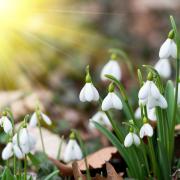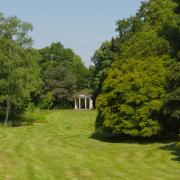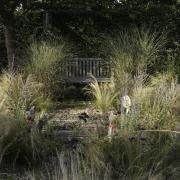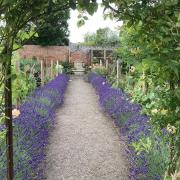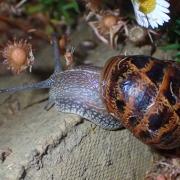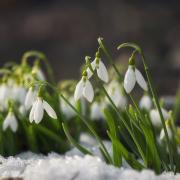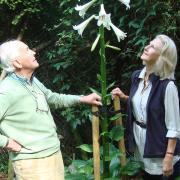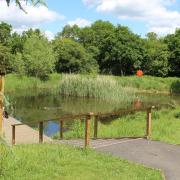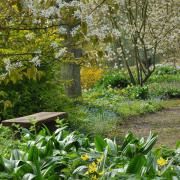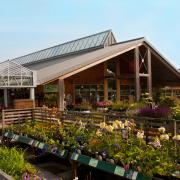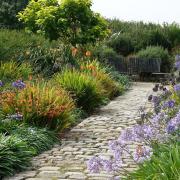Exotic planting and a wonderful display of colour from thousands of plants make Chris and Linda Pegden’s garden at Fingringhoe a popular place to visit, discovers Philippa Pearson

Gardening has always been a passion for Chris Pegden, but it was a neighbour who inspired him to share his colourful quarter-of-an-acre garden at Fingringhoe with others.
‘One afternoon, a neighbour leaned over the fence and said we should open our garden for the local church,’ recalls Chris. Opening their garden to the public wasn’t something that Chris and his wife Linda had thought about doing, but it seemed a good idea. The couple moved to Tudor Roost in Fingringhoe in 1992, inheriting a garden that was just a very overgrown lawn, and set about creating what is now a delightful space that is brimming with interesting plants.

‘We’ve planted everything that you see,’ explains Chris, ‘including all the trees.’ The garden has literally thousands of plants with many in groups, such as the obelisks made by Chris that are covered with climbing roses and clematis. ‘There are more than 100 different roses and 80 clematis throughout the garden,’ Chris advises, ‘plus 15 acers and groups of many other different plants.’
Chris and Linda opened their garden for the local church for the first time in 1995 and then later for the National Garden Scheme (NGS). This year will be the 15th year they have opened for this popular charity, having raised more than £25,000 since they first opened for them in 1999. This is a tremendous achievement and both Chris and Linda are proud and delighted that so many people have taken the time to visit their garden, which is usually open for eight days between Easter and the end of August for the NGS.

Chris remembers the first border they dug out after clearing the overgrown garden. ‘It was only 8 x 4 feet, but it seemed huge at the time,’ he explains, adding that they planted the border with small conifers. But small plants grow into big plants and the 20ft high conifers were taken out a little while ago to make room for seasonal displays of spring bulbs followed by a hot summer planting scheme. One plant has remained in the old conifer bed, an Araucaria araucana Monkey Puzzle tree now reaching 30ft high, but bought as a 6inch sapling for £1 in Scotland by Chris in 1997.
Elsewhere, manicured grassy paths lead around more island beds and ponds with planting designed to attract wildlife as well as being very colourful.
‘We’ve got every colour here and we don’t mind clashes,’ smiles Chris, who has chosen plants that offer colour and interest throughout the seasons.
A densely-planted sub-tropical area has architectural and exotic specimens including cannas, bananas, palms, agapanthus, agaves and tree ferns that surround a colourful gazebo. Many of these tender plants need to be overwintered and used to be kept in the two greenhouses in the garden, until a conservatory was added to the house. Used as a tea room on open days in spring and summer, the conservatory is the perfect place to overwinter the tender tropical plants which are in pots, about 20 of them, even though they take up a fair bit of room.
‘It feels a bit like a Kew Garden hot house in there during the winter,’ laughs Linda, ‘but the effect is really lovely.’ Out in the garden, hardier tree ferns, bananas and other exotics are protected through the winter. Chris wraps three layers of fleece around the trunks of the tree ferns, then pads the inside with old leaves and more fleece, while the banana plants have a similar treatment with a chicken wire cage, fleece and a straw mulch to protect the plants from the worst of the winter weather.
Each year Chris and Linda change something in the garden, whether adding new planting or removing a tree or two to make room for new borders and plant collections. The garden backs onto Fingringhoe Wick Nature Reserve, that was once a gravel extraction area, and the soil at Tudor Roost is free draining with only one small patch of clay. Chris and Linda make their own compost, which is mulched back into the borders along with well-rotted horse manure to keep the soil in good condition and maintain moisture. Chris grows many plants from seed, some collected on caravanning holidays across Europe, so there’s a good selection of plants to buy on open days and dogs are also allowed, if on a lead. After opening for 15 years for the NGS, Chris and Linda have no plans to stop opening the gates of their inspirational garden to the public and hope to keep on raising lots of money for this deserving charity.
Visit the garden
Tudor Roost
18 Frere Way
Fingringhoe
Colchester
Essex
CO5 7BP
You can call Chris and Linda Pegden on
01206 729831 or email pegdenc@gmail.com
The garden is open from 2pm to 5pm for the NGS on July 26 and 27 and August 24 and 25. Visitors are also welcome by appointment from April to August. Admission is £3.50 for adults with children free. Homemade teas and plants are available for sale and dogs are welcome on leads.




